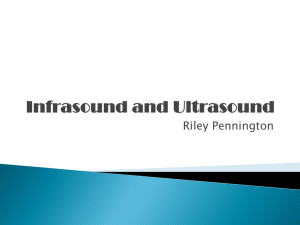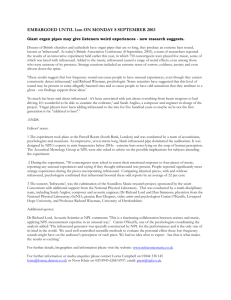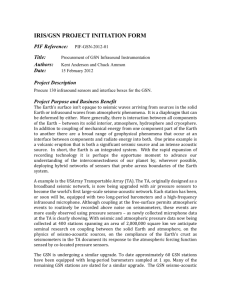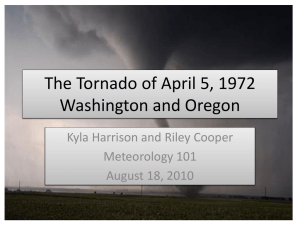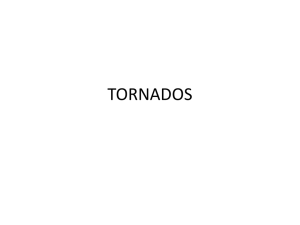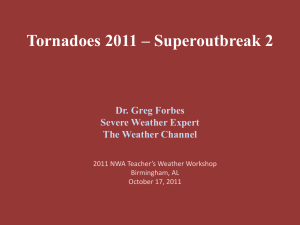Presented - Copernicus.org
advertisement
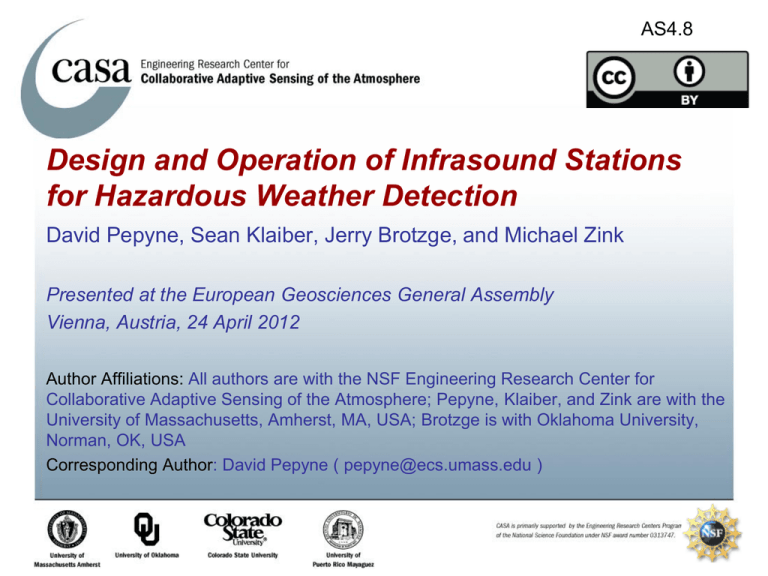
AS4.8 Design and Operation of Infrasound Stations for Hazardous Weather Detection David Pepyne, Sean Klaiber, Jerry Brotzge, and Michael Zink Presented at the European Geosciences General Assembly Vienna, Austria, 24 April 2012 Author Affiliations: All authors are with the NSF Engineering Research Center for Collaborative Adaptive Sensing of the Atmosphere; Pepyne, Klaiber, and Zink are with the University of Massachusetts, Amherst, MA, USA; Brotzge is with Oklahoma University, Norman, OK, USA Corresponding Author: David Pepyne ( pepyne@ecs.umass.edu ) 1. Introduction Each year tornadoes cause property damage and death, some of which might be avoided with increased tornado warning lead time. In 2011 there were 1691 tornadoes in the U.S. resulting in 550 deaths and property damages approaching $25 billion. 3 April 2012 Dallas Texas: Given more lead time, could these trucks have been moved out of harm’s way? 1 Today, tornado warnings are issued based on observations from ground-based Doppler weather radar: In the U.S., from the WSR-88D, NEXRAD, Sband radar. Radar beams travel essentially straight lines over a curved earth. Thus, far from the radar, the severe weather that impacts human activities can lie below the view of a long range radar. With respect to tornadoes, the result is that: >25% of tornadoes go undetected 80% of tornado warnings are false alarms Average tornado warning lead time is 12 minutes. Weather hazards 2 NEXRAD coverage at 1 km AGL The Center for Collaborative Adaptive Sensing of the Atmosphere (CASA) is one of 15 U.S. National Science Foundation Engineering Research Centers. Funded for 10 years to solve the systems engineering challenges associated with the deployment of sensor networks for improving weather hazard prediction, detection, tracking, and response. CASA’s main research focus is related to small, low-cost radars to fill the low-altitude coverage gaps [1]. Small, mechanically scanned dish radars on short towers and rooftops. Small, phased-array flat-panel radars on cell towers and other existing infrastructure. CASA – fill the gaps by putting radars in the white spaces: instead of 150 large radars, 1000+ small radars! [1] McLaughlin et al, “Short-Wavelength Technology and the Potential for 3 Distributed Networks of Small Radar Systems,” Bulletin of the American Meteorology Society, 90, pp. 1797-1817, 2009. Recently, CASA has extended its research to investigate improved weather hazard warnings through a Networks of Networks (NoNs) approach. Additional sensors to include advanced barometers, LIDAR, mesonet stations, rain gauges, GPS water vapor estimation, etc. Work by Bedard and others showed that tornadoes generate infrasound in the 0.510Hz frequency range [2],[3]. Precursor infrasounds are sometimes detected 30min to 1hr prior to vortex touchdown. This is 15-45min earlier than the current average tornado warning lead time in the U.S. Integrating infrasound into the weather hazard warning infrastructure, therefore, has the http://www.esrl.noaa.gov/psd/programs/infrasound/isnet/ potential to improve tornado warning and response. [2] Bedard et al, “The Infrasound Network (ISNET): Background, Design, Details, and Display Capabilities as an 88D Adjunct Tornado Detection Tool,” Proc. of the 22nd AMS Conf. on Severe Local Storms, Hyannis, MA, 4-8 Oct. 2004. 4 [3] Bedard et al, “Overview of the ISNET Data Set and Conclusions and Recommendations from a March 2004 Workshop to Review the ISNET Data,” Proc. of the 22nd AMS Conf. on Severe Local Storms, Hyannis, MA, 4-8 Oct. 2004. In the spring of 2011, CASA conducted an infrasound field experiment in the U.S. state of Oklahoma (see [4], [5] for background and preliminary results). Two infrasound monitoring stations placed in the heart of “tornado alley” where statistically the majority of tornadoes in the U.S. occur. This being CASA’s first infrasound experiment, the goals were to understand the issues involved in the design and operation of infrasound stations for severe weather monitoring and early warning. 2011 CASA Infrasound Field Experiment 5 [4] Pepyne et al, “An Integrated Radar-Infrasound Network for Meteorological Infrasound Detection and Analysis,” Proc. 91st AMS Annual Meeting, IOAS-AOLS, Seattle, WA, January 2011. [5] Pepyne and Klaiber, “Highlights from the 2011 CASA Infrasound Field Experiment,” Proc. 92 nd AMS Annual Meeting, IOAS-AOLS, New Orleans, LA, January 2012. 2. Infrasound Station Deployment Infrasound is low frequency sound, < 20Hz. At such low frequencies, sound experiences very little attenuation and can be detected at very long distances. Propagation speed, however, is fairly slow, ~340m/s. For hazard early-warning, therefore, stations should be no more than ~100km from the emitter: 100km @ 340m/s = ~5min propagation delay. Moreover, because the speed of sound varies with temperature, and temperature first decreases then increases with altitude, the atmosphere acts as an acoustic “waveguide”. Waveguide effect can produce an “acoustic shadow” starting ~30km from the emitter. 6 Acoustic Shadow Figure from: Skowbo, Muh, and Fanto, “Infrasound Sensor System Detection of Atlas V Rocket Launch,” Technology Review Journal, Spring/Summer, 2009. The vision for comprehensive monitoring is a dense network of infrasound stations spaced ~30km apart. This would ensure detection at two or more stations with a propagation delay < 2min after initial infrasound emission. With detection at two or more stations, triangulation is then be used to determine the emitter location. 30 km spacing Triangulation of a tornado within a unit cell of a network of infrasound stations. 30km spacing between infrasound stations ensures detection < 2 minutes after initial infrasound emission. 7 3. Station Design 30km spacing implies that thousands of infrasound stations would be needed to cover the region east of the U.S. Rocky Mountains, the area of the U.S. most prone to tornadoes. With thousands of stations, each must be very low cost: Low equipment acquisition and Sensors + deployment cost wind filters Small land use footprint Easy to maintain and operate Data cables An infrasound stations consists of, Infrasound sensors Wind filtering equipment Data logging and communication equipment 8 Data logging + communication equipment The infrasound sensors selected were Paroscientific, Inc., Model 6000-16B barometers. Convert the vibration frequency of a quartz crystal 9 into a pressure measurement. Have a “nano-resolution/infrasound” mode giving high-resolution measurements at sample rates >20Hz. A built-in, user configurable anti-alias filter removes high-frequency noise prior to sampling. No need for expensive calibration. Factory calibration is maintained over the lifetime of the barometer. Internal circuitry maintains measurement accuracy with temperature change, so the barometers do not need to be placed inside a temperature controlled enclosure. Digital RS232/RS485 ASCII output makes data acquisition trivial. One can do experiments with a laptop, powering the barometers through a USB power cable. Being a barometer, these instruments can sense the whole range of infrasound frequencies from DC (absolute barometric pressure) up. Paroscientific Model 6000-16B 4 Paroscientific barometers controlled from a laptop through a USB-to-serial MUX An infrasound station needs at least 3 sensors to be able Wind Filters to determine the arrival direction of an infrasound signal. More sensors give better sensitivity and better direction-of- arrival accuracy over a wider range of emitter frequencies. Each infrasound sensor needs a filter to mitigate wind noise. Currently, the best solutions are analog spatial filters consisting of pipes or hoses laid out on the ground around each sensor. For very high wind speeds it may be necessary to put fences around the spatial wind filter to slow the wind and lift it off the surface. The lower the frequency of interest, the larger the required diameter of the spatial filter. Pipe Arrays Sensors are small and relatively inexpensive, wind filters are physically large and must be protected from grazing animals (e.g., cows). The large land area required for the spatial wind filters can be a major impediment to deployment. Cost of infrasound stations is driven by the number of sensors – one must trade-off performance and cost! Soaker Hoses Fences 10 Figures from: Hedlin, M.A.H., J. Berger, and M. Zumberge, “Evaluation of Infrasonic Spatial Filters.” To control costs, we used 4 sensors arranged in a square topology with 50m spacing between sensors. Has redundancy in that the failure of a single sensor will not prevent being able to estimate infrasound direction-of-arrival. The limitation of using a sensor array with a fixed size aperture is that direction-of-arrival estimation accuracy will then depend on the frequency of the infrasound signal. Spatial aliasing occurs for infrasound frequencies with wavelength > 2 times the sensor spacing. In our case, spatial aliasing occurs for frequencies > ~3.4Hz. 11 Array gain patterns for a 4 sensor square array 50m on a side as a function of frequency. The figure on the far right shows the spatial aliasing that occurs at infrasound frequencies above ~3.4Hz. For wind filtering, we used 8-arm, 15m diameter porous “soaker” hose wind filters. Such filters are inexpensive and very easy to deploy. They may, however, require fencing to protect them from grazing animals, such as cows. Such filters are also limited in that there are no mathematical models for predicting their performance and they may give inconsistent, time-varying results as they get wet and as the soaker hose material degrades with time. Close-up of soaker hoses, summing manifold, and barometer enclosure. 12 8-arm, 15m diameter soaker hose wind filter Wind filter at one of our Oklahoma stations surrounded by a cow fence. The orange bucket in the center contains the barometer. The white sensor on the pole measures wind speed and direction. 4. Results Two infrasound monitoring stations were deployed. One in Cyril, Oklahoma (designated KCYR) and one in Rush Springs, Oklahoma (designated KRSP). The two stations were ~30km apart. The infrasound monitoring stations were collocated with two of CASA’s mechanically scanned X-band weather radars. 71 days of pressure data was collected at both stations from 18 April to 27 June 2011. 20 days of wind speed and direction data was collected at the Cyril station from 2 June to 21 June 2011. 13 Cyril Rush Springs There were 1691 tornadoes in the U.S. in 2011. One tornado detection case occurred on 22 May 2011. The same night as the Joplin, MO EF5 tornado (159 dead; thousands injured). The spectrogram data was unremarkable, The cohereogram data showed strong coherence in the frequency band < ~1.5Hz. 14 Bearing angle estimation analysis showed strong correlation, with direction-of-arrival from the southeast relative to both stations. 15 On a map, the stations point directly towards a line of tornadoes moving north-northeast from Texas. Radar image from: http://www.mmm.ucar.edu/imagearchive/ 16 In addition to severe weather detections, we got hundreds of hours of “banded” spectrogram data. This spectral banding was coherent between the sensors at the arrays. In general, the signal was stronger at the Cyril station than at the Rush Springs station. 17 Our first thought was that the banding might be due to resonance in the spatial wind filter hoses. Pipe arrays are prone to resonance; porous hoses less so. This thought was not supported by a bearing angle analysis. Bearing angle analysis generated solutions with a very focused and consistent direction-of-arrival. 18 Triangulation using the mean bearing estimates from the two infrasound stations point directly to the Blue Canyon windfarm as being the source of the signal. Blue Canyon is the largest windfarm in the state of Oklahoma, containing more than 100, 1+ megawatt wind turbines. Blue Canyon Windfarm ~30km west of the Cyril (KCYR) station and ~60km west of the Rush Springs (KRSP) station. 19 In Oklahoma alone, there were some 69 tornadoes during the period of infrasound collection. Including an EF4 that occurred less than 30km from the two stations (the Chickasha/Newcastle tornado outbreak on 24 May 2011). Of these, we recorded only 2 clear tornado cases. Neither from a tornado in the 30km “early-warning” range of the infrasound stations. The cause was poor wind filter performance. Using the 21 days of wind speed and direction data recorded at the Cyril station, we performed a wind filter analysis. 20 Wind speed and direction data recorded at the Cyril (KCYR) station over the period 2 June to 22 June 2011. As seen from the power spectral density plots, our soaker hose wind filter was ineffective for wind speeds > ~5m/s. Above 7m/s can no longer see the windfarm signal. Winds when tornadoes are nearby can be expected to be much higher, 10-15m/s. Need ~20dB additional noise reduction at 10m/s. 21 5. Summary This poster described CASA’s initial efforts towards low-cost, but effective infrasound monitoring stations. Four Paroscientific Model 6000-16B barometers arranged in a square topology with 50 meter aperture appears suitable for the detection and geolocation of severe weather infrasound emitters. Wind filtering is the biggest challenge and biggest impediment to successful infrasound monitoring. Our simple soaker hose wind filter was almost completely ineffective for wind speeds above ~5m/s. Bedard in his tornado detection work found a combination of soaker hose spatial wind filters + eddy fences was required. The land use, permitting and construction costs of such fencing, however, not only more than doubles the cost of a deployment, it also severely limits where the infrasound stations can be deployed. Even in Oklahoma, with its wide open parries, we are having trouble getting the land use permissions to experiment with eddy fencing! Eddy fence used by Bedard for infrasound tornado detection – 2 meters tall, 15 meters diameter, covered with semi-porous mesh, and 22 capped with a plywood crown. Need one around every sensor On-going work is looking into other ways, besides analog spatial filtering, to deal with wind noise. These include techniques based on adaptive filtering, adaptive noise cancellation, and techniques for detecting sinusoids and impulses in power law noise (e.g., wavelet based techniques) to name a few. Other applications Wind energy is growing in popularity around the world, as are concerns about the acoustic emissions from wind turbines. In the U.S., most acoustic emissions studies are only concerned with audible noise (> 35Hz) at a given offset from the wind turbine. The windfarm detected in our experiment here had its fundamental at 0.8Hz. What are the infrasound emission levels at these frequencies at the noise offsets deemed suitable for audible emissions? Do the infrasound emission at these levels have negative human impacts? For these studies too, wind filtering will be an issue. What is a simple wind filter design for wind turbine infrasound measurement studies? 23 Acknowledgements Funding for this work is provided by the Jerome M. Paros fund for Measurement and Environmental Sciences Research; the Engineering Research Centers program of the National Science Foundation (NSF) under NSF Cooperative Agreement EEC-0313747; and by the NSF Research Experience for Undergraduates (REU) program. 24
